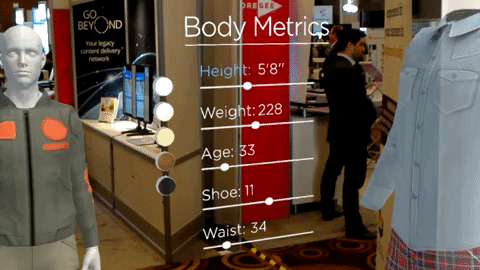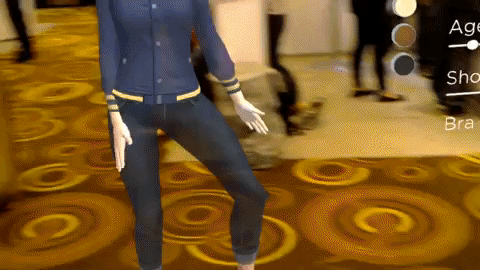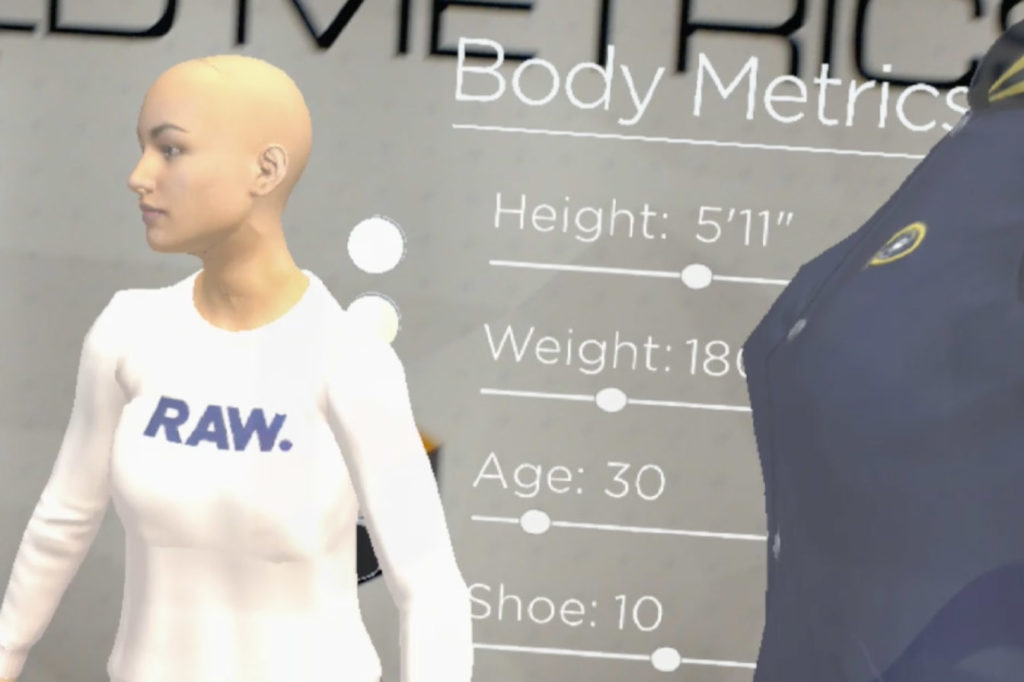Imagine taking the hassle and guesswork out of clothing shopping. Instead of picking out several pieces of clothing, trying them on in a dressing room, and repeating everything if they don’t fit or look good, you could see exactly how clothing fits while shopping. That’s the task that character creation platform Morph3D, took on in developing the Virtual Dressing Room—a technology demonstration that could potentially change up how consumers shop.
Augmented reality has been used in shopping for products like furniture and art, but this is the first step in offering a high level of customization by fusing technology with something as dynamic as clothes. The Microsoft HoloLens app is developed in partnership with software technology company, Bold Metrics. The two companies came together when the demo was shown at Shoptalk, one of the largest retail conventions in the world, and the two then decided to approach the Dutch designer clothing company G-Star to provide the fashion featured in the Dressing Room.

“The goal of this collaboration was to present the future of retail,” Berk Frei, VP of innovation and strategy at Morph3D, told AListDaily, describing how the app came together. “Our mission as a company is to make the creation of virtual identities easy, meaningful and affordable across different verticals. We see virtual identities [being used] in a lot of places. For instance, we have a lot of traction in social VR, partnering with companies like High Fidelity. There are many companies interested in helping people create digital characters (avatars) in business, education and retail. So, we wanted to demonstrate our vision of where we think virtual identities are going.”
Frei then talked about partnering with Bold Metrics and G-Star to bring the Virtual Dressing Room to life. “Bold Metrics has an algorithm and body scanning technology that uses machine learning and AI,” he explained. “Using some basic questions, it is able to accurately predict 90 measurements of your body and physique. They had a similar vision as ours—virtual figures for retail. Together, we found an innovative brand partner with G-Star, which was also interested in exploring this proof of concept.”
The Augmented Reality Shopping Experience
After putting on a HoloLens, users will see a blank figure surrounded by a virtual wardrobe comprised of G-Star clothing, and this virtual mannequin can be controlled and changed using voice commands. Users can change its position, have it put its hands on its hips, or take various other poses. The figure can even be told to perform actions like running or boxing so that users can see how the clothing looks when in action. Users can also get up close and examine the clothes before gazing at an article of clothing and pinching their fingers on it in the augmented reality space to put them onto the virtual model.
But the real magic is creating the custom avatar. Users are presented with a series of questions that ask about their age, height, weight, waist size and shoe sizes (women are asked for their bra sizes instead of waists). With those answers, the program configures the mannequin to match the user’s body measurements without having to break out the measuring tape.

Frei remarked on how Bold Metrics’ method compares to having people scanned in-store. “Scanning technology is still esoteric, hard to find, bulky and expensive,” he said. “What’s cool about this is that you can quickly answer these questions and get a figure that proportionately looks like you and is dynamic. Scanned data can’t initially be used in this context—it can’t be moved, changed, positioned or posed. What we’re proposing should be very approachable to a mainstream audience. Also, because it’s not a body scan, you could use it shop for your friends and family.”
Morph3D brought G-Star’s brand of fashion into the app by having 3D artists design the clothing using reference materials provided by the company. It also used a scanning solution that took in data and brought it into the app. Using these methods, companies could fill the Virtual Dressing Room app with their entire selection of clothing.
When asked how he imagined the Virtual Dressing Room might be used by stores, Frei said, “We talked about a couple phases of where this might be interesting as the technology matures. Our partners saw a lot of opportunity in the in brick-and-mortar space for creating compelling and interesting experiences that will bring people to stores, giving them a reason to come out. There’s something really cool about having a virtual dressing room in a store. We imagine a scenario where someone could use the Virtual Dressing Room to blast through the entire catalog to come up with looks that they’re interested in. Not only are they having a novel, one-of-a-kind experience, but it’s something that could help them come to a purchase decision sooner.”
Frei imagines that the entire shopping experience could be as easy as swiping left or right to quickly sort through a clothing catalog, which could potentially connect to online offerings, expanding the shopping experience past the in-store selection.
“We see opportunities to create unique store experiences with the Virtual Dressing Room,” said Frei. “We demonstrated it as a location-based experience, but we can see it being used more broadly for online shopping. It could be an engine that helps drive retail.”
Retail, Online Or Mobile?
Frei doesn’t think the technology should necessarily be limited to AR headsets like the HoloLens. “The HoloLens is incidental to the demonstration—it’s not something we highlight when we talk to vendors,” said Frei. “There aren’t many of them out there, but it’s really cool when you see one. We saw it as a cool way to present this experience, but it can be used with phones, web pages and virtual reality headsets. It doesn’t matter what hardware you use.”
That being said, we asked Frei if he thought the app might be better suited for online shopping. “I’ve wrestled with that for a little bit because I’m intrigued by both possibilities,” he answered. “I don’t shop for clothing or shoes online because I don’t have a way to associate with the product, but that’s essentially what we’re solving. With our technology, we can associate any product with people’s body types. That isn’t limited to fashion, it could extend to furniture, bicycles and so on. I would love to feel confident about purchasing items in those categories online, but I don’t think anything can replace trying things on and feeling their texture. There’s something about experiencing something in a physical way.” Frei then explained that the Virtual Dressing Room is meant to streamline the shopping experience, not replace it, by helping users pick out the clothes that they are almost certain that they want before actually putting it on.

Frei also noted how there isn’t the same kind of “magical” experience when using the app on screened devices such as smartphones. This observation includes Google Tango, which is designed specifically for augmented reality applications. Although Frei supports handheld devices, he states: “[Headsets have] true scale and you’re not looking through a window. There’s something disconnecting when you’re looking through the screen of a phone. We wanted people to be intrigued by the experience.”
So why should retailers turn to augmented reality? “You hear people talking about how companies like Apple, Magic Leap and Meta are investing heavily in the technology, but I don’t think people understand why these tech companies are chasing augmented reality,” Frei explained. “Until you experience something like this demonstration, you don’t realize the incredible utility that AR has to offer—and seeing things in AR is such a cool experience. We firmly believe that augmented reality is an amazing technology that is developing and we want to be pioneers in that space.
“This demo demonstrates why AR matters to everyday people. Augmented reality is going to be important in helping you interact with data in a way that has never been experienced before. I think this could be a very interesting experience to put in stores to help drive interest in the store, brand and products.”
Digitally Connecting People With Brands
Frei then expanded on the topic of avatars by talking about how it could be used more broadly to connect individuals with brands using virtual personas. “We see a future where people have virtual identities that are used in different contexts,” he said. “You’ll pull up an avatar that is a realistic representation of yourself that can be used in retail, education and business. Then you can have identities that are more playful, such as a troll or elf. That’s the ecosystem that we’re trying to create with our technology, platform and brand partners. We do this because we think it matters and we want to be leaders in this space. Persistent virtual identities and personas are going to be used in so many different ways, and we wanted to lead the way with this demonstration.”

